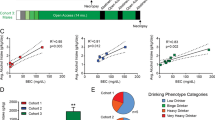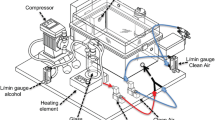Abstract
Rationale
Abstinence-based approaches to treating alcohol use disorder (AUD) are highly prevalent, but abstinence from chronic drinking may exacerbate subsequent levels of alcohol intake in relapse.
Objective
Use a non-human primate model that encompasses a range of chronic voluntary ethanol drinking to isolate biological responses to repeated cycles of imposed abstinence as a function of baseline voluntary alcohol drinking levels.
Methods
Over a 26-month protocol, young adult male rhesus macaques were first induced to drink alcohol and then given continuous access to 4% (w/v) ethanol (n = 8) or water (n = 4) for approximately 14 months, followed by three 28- to 35-day abstinence phases, with 3 months of ethanol access in between. Ethanol intake and blood ethanol concentration (BEC) were the primary dependent variables. Observational signs of physical dependence and circulating ACTH and cortisol were monitored.
Results
Prior to abstinence, stable, categorical, individual differences in voluntary ethanol intake under chronic access conditions were found. Following abstinence, categorical “non-heavy” drinking subjects increased drinking transiently (increased between 0.7 and 1.4 g/kg/day in first month after abstinence) but returned to baseline after 3 months. Categorical “heavy” drinkers, however, maintained drinking 1.0–2.6 g/kg above baseline for over 3 months following abstinence. Signs of physical dependence were rare, although huddling and social withdrawal increased in ethanol and control subjects. The most prominent effect on hormonal measures was heightened cortisol during abstinence that increased to a greater extent in ethanol subjects.
Conclusion
Involuntary abstinence increases drinking in the absence of overt physical withdrawal symptoms, and heavy drinkers are more robustly affected compared to non-heavy drinkers.




Similar content being viewed by others
References
Adinoff B, Risher-Flowers D, De Jong J, Ravitz B, Bone GH, Nutt DJ, Roehrich L, Martin PR, Linnoila M (1991) Disturbances of hypothalamic-pituitary-adrenal axis functioning during ethanol withdrawal in six men. Am J Psychiatry 148:1023–1025
Adinoff B, Ruether K, Krebaum S, Iranmanesh A, Williams MJ (2003) Increased salivary cortisol concentrations during chronic alcohol intoxication in a naturalistic clinical sample of men. Alcohol Clin Exp Res 27:1420–1427
American Psychological Association (2013) Diagnostic and statistical manual of mental disorders, 5th edn. American Psychiatric Association, Washington DC, p 493
Anderson RI, Lopez MF, Becker HC (2016) Forced swim stress increases ethanol consumption in C57BL/6J mice with a history of chronic intermittent ethanol exposure. Psychopharmacology 233:2035–2043
Baker EJ, Farro J, Gonzales S, Helms C, Grant KA (2014) Chronic alcohol self-administration in monkeys shows long-term quantity/frequency categorical stability. Alcohol Clin Exp Res 38:2835–2843
Baker EJ, Walter NA, Salo A, Rivas Perea P, Moore S, Gonzales S, Grant KA (2017) Identifying future drinkers: behavioral analysis of monkeys initiating drinking to intoxication is predictive of future drinking classification. Alcohol Clin Exp Res 41:626–636
Beattie MC, Maldonado-Devincci AM, Porcu P, O'Buckley TK, Daunais JB, Grant KA, Morrow AL (2015) Voluntary ethanol consumption reduces GABAergic neuroactive steroid (3α,5α)3-hydroxypregnan-20-one (3α,5α-THP) in the amygdala of the cynomolgus monkey. Addict Biol. https://doi.org/10.1111/adb.12326
Becker HC (1998) Kindling in alcohol withdrawal. Alcohol Health Res World 22:25–33
Becker HC, Hale RL (1993) Repeated episodes of ethanol withdrawal potentiate the severity of subsequent withdrawal seizures: an animal model of alcohol withdrawal “kindling”. Alcohol Clin Exp Res 17:94–98
Becker HC, Lopez MF (2004) Increased ethanol drinking after repeated chronic ethanol exposure and withdrawal experience in C57BL/6 mice. Alcohol Clin Exp Res 28:1829–1838
Cervera-Juanes R, Wilhelm LJ, Park B, Grant KA, Ferguson B (2016a) Genome-wide analysis of the nucleus accumbens identifies DNA methylation signals differentiating low/binge from heavy alcohol drinking. Alcohol. https://doi.org/10.1016/j.alcohol.2016.11.003
Cervera-Juanes R, Wilhem LJ, Park B, Lee R, Locke J, Helms C, Gonzales S, Wand G, Jones SR, Grant KA, Ferguson B (2016b) MAOA expression predicts vulnerability for alcohol use. Mol Psychiatry 21:472–479
Cervera-Juanes R, Wilhelm LJ, Park B, Grant KA, Ferguson B (2017) Alcohol-dose-dependent DNA methylation and expression in the nucleus accumbens identifies coordinated regulation of synaptic genes. Transl Psychiatry 7:e994
Corbit LH, Nie H, Janak PH (2012) Habitual alcohol seeking: time course and the contribution of subregions of the dorsal striatum. Biol Psychiatry 72:389–395
Cuzon Carlson VC, Seabold GK, Helms CM, Garg N, Odagiri M, Rau AR, Daunais J, Alvarez VA, Lovinger DM, Grant KA (2011) Synaptic and morphological neuroadaptations in the putamen associated with long-term, relapsing alcohol drinking in primates. Neuropsychopharmacology 36:2513–2528
Delucchi KL, Kaskutas LA (2010) Following problem drinkers over eleven years: understanding changes in alcohol consumption. J Stud Alcohol Drugs 71:831–836
Everitt BJ, Robbins TW (2005) Neural systems of reinforcement for drug addiction: from actions to habits to compulsion. Nat Neurosci 8:1481–1489
Food and Drug Administration (2006) Food and drug administration. In: Medical review of Vivitrol. Rockville, MD pp. 21–897
Gerdeman GL, Partridge JG, Lupica CR, Lovinger DM (2003) It could be habit forming: drugs of abuse and striatal synaptic plasticity. Trends Neurosci 26:184–192
Grant KA, Leng X, Green HL, Szeliga KT, Rogers LS, Gonzales SW (2008) Drinking typography established by scheduled induction predicts chronic heavy drinking in a monkey model of ethanol self-administration. Alcohol Clin Exp Res 32:1824–1838
Griffin WC 3rd, Lopez MF, Becker HC (2009) Intensity and duration of chronic ethanol exposure is critical for subsequent escalation of voluntary ethanol drinking in mice. Alcohol Clin Exp Res 33:1893–1900
Hauser SR, Deehan GA Jr, Knight CP, Toalston JE, McBride WJ, Rodd ZA (2016) Parameters of context-induced ethanol (EtOH)-seeking in alcohol-preferring (P) rats: temporal analysis, effects of repeated deprivation, and EtOH priming injections. Alcohol Clin Exp Res 40:2229–2239
Helms CM, McClintick MN, Grant KA (2012) Social rank, chronic ethanol self-administration, and diurnal pituitary-adrenal activity in cynomolgus monkeys. Psychopharmacology 224:133–143
Helms CM, Park B, Grant KA (2014) Adrenal steroid hormones and ethanol self-administration in male rhesus macaques. Psychopharmacology 231:3425–3436
Holleran KM, Winder DG (2017) Preclinical voluntary drinking models for alcohol abstinence-induced affective disturbances in mice. Genes Brain Behav 16:8–14
Holtyn AF, Kaminski BJ, Wand GS, Weerts EM (2014) Differences in extinction of cue-maintained conditioned responses associated with self-administration: Alcohol versus a nonalcoholic reinforcer. Alcohol Clin Exp Res 38:2639–2646
Iranmanesh A, Veldhuis JD, Johnson ML, Lizarralde G (1989) 24-hour pulsatile and circadian patterns of cortisol secretion in alcoholic men. J Androl 10:54–63
Jimenez VA, Grant KA (2017) Studies using macaque monkeys to address excessive alcohol drinking and stress interactions. Neuropharmacology. https://doi.org/10.1016/j.neuropharm.2017.03.027
Jimenez VA, Porcu P, Morrow AL, Grant KA (2017a) Adaptations in basal and hypothalamic-pituitary-adrenal-activated deoxycorticosterone responses following ethanol self-administration in cynomolgus monkeys. Front Endocrinol 8:19
Jimenez VA, Allen DC, McClintick MN, Grant KA (2017b) Social setting, social rank and HPA axis response in cynomolgus monkeys. Psychopharmacology. https://doi.org/10.1007/s00213-017-4596-7
Kornet M, Goosen C, Van Ree JM (1990) The effect of interrupted alcohol supply on spontaneous alcohol consumption by rhesus monkeys. Alcohol Alcohol 25:407–412
Kornet M, Goosen C, Van Ree JM (1991) Effect of naltrexone on alcohol consumption during chronic alcohol drinking and after a period of imposed abstinence in free-choice drinking rhesus monkeys. Psychopharmacology 104:367–376
Kwako LE, Schwandt ML, Sells JR, Ramchandani VA, Hommer DW, George DT, Sinha R, Heilig M (2014) Methods for inducing alcohol craving in individuals with co-morbid alcohol dependence and posttraumatic stress disorder: behavioral and physiological outcomes. Addict Biol 20:733–746
Larimer ME, Palmer RS, Marlatt GA (1999) Relapse prevention. an overview of Marlatt’s cognitive-behavioral model. Alcohol Res Health 23:151–160
Lemolo A, Valenza M, Tozier L, Knapp CM, Kornetsky C, Steardo L, Sabino V, Cottone P (2012) Withdrawal from chronic, intermittent access to a highly palatable food induces depressive-like behavior in compulvive eating rats. Behav Pharmacol 23:593–602
Marlatt G, Gordon J (1985) Relapse prevention: a self-control strategy for the maintenance of behavior change. Guilford, New York, pp 85–101
Matzger H, Kaskutas LA, Weisner C (2005) Reasons for drinking less and their relationship to sustained remission from problem drinking. Addiction 100:1637–1646
National Institute on Alcohol Abuse and Alcoholism (2015) Alcohol overdose: the dangers of drinking too much. In: Brochures and Fact Sheets. Available via NIAAA. https://pubs.niaaa.nih.gov/publications/alcoholoverdosefactsheet/overdoseFact.pdf Accessed 20 Nov 2016
Nimitvilai S, Uys JD, Woodward JJ, Randall PK, Ball LE, Williams RW, Jones BC, Lu L, Grant KA, Mulholland PJ (2017) Orbitofrontal neuroadaptations and cross-species synaptic biomarkers in heavy-drinking macaques. J Neurosci 37:3646–3660
O'Tousa D, Grahame N (2014) Habit formation: implications for alcoholism research. Alcohol 48:327–335
Pleil KE, Helms CM, Sobus JR, Daunais JB, Grant KA, Kash TL (2016) Effects of chronic alcohol consumption on neuronal function in the non-human primate BNST. Addict Biol 21:1151–1167. https://doi.org/10.1111/adb.12289
Polich JM, Armor DJ, Braiker HB (1981) Stability and change in drinking patterns. In: The Course of Alcoholism: Four Years After Treatment. New York: John Wiley & Sons, 1981. pp. 159–200
Ruedi-Bettschen D, Rowlett JK, Rallapalli S, Clayton T, Cook JM, Platt DM (2013) Modulation of alpha5 subunit-containing GABAA receptors alters alcohol drinking by rhesus monkeys. Alcohol Clin Exp Res 37:624–634
Sanchis–Segura C, Spanagel R (2006) Behavioural assessment of drug reinforcement and addictive features in rodents: an overview. Addict Biol 11:2–38
Siciliano CA, Calipari ES, Yorgason JT, Lovinger DM, Mateo Y, Jimenez VA, Helms CM, Grant KA, Jones SR (2016a) Increased presynaptic regulation of dopamine neurotransmission in the nucleus accumbens core following chronic ethanol self-administration in female macaques. Psychopharmacology 233:1435–1443
Siciliano CA, Calipari ES, Yorgason JT, Mateo Y, Helms CM, Lovinger DM, Grant KA, Jones SR (2016b) Chronic ethanol self-administration in macaques shifts dopamine feedback inhibition to predominantly D2 receptors in nucleus accumbens core. Drug Alcohol Depend 158:159–163
Sinclair JD, Senter RJ (1968) Development of an alcohol-deprivation effect in rats. Q J Stud Alcohol 29:863–867
Sinha R, Fox HC, Hong KA, Bergquist K, Bhagwagar Z, Siedlarz KM (2009) Enhanced negative emotion and alcohol craving, and altered physiological responses following stress and cue exposure in alcohol dependent individuals. Neuropsychopharmacology 34:1198–1208
Smith ML, Hostetler CM, Heinricher MM, Ryabinin AE (2016) Social transfer of pain in mice. Sci Adv 2:e1600855
Spanagel R (2000) Recent animal models of alcoholism. Alcohol Res Health 24:124–131
Spanagel R, Holter SM (1999) Long-term alcohol self-administration with repeated alcohol deprivation phases: an animal model of alcoholism? Alcohol Alcohol 34:231–243
Witkiewitz K (2005) Defining relapse from a harm reduction perspective. J Evid Based Soc Work 2:191–206
Witkiewitz K, Marlatt AG (2006) Overview of harm reduction treatments for alcohol problems. Int J Drug Policy 17:285–294
Witkiewitz K, Masyn KE (2008) Drinking trajectories following an initial lapse. Psychol Addict Behav 22:157–167
Yin HH, Park BS, Adermark L, Lovinger DM (2007) Ethanol reverses the direction of long-term synaptic plasticity in the dorsomedial striatum. Eur J Neurosci 25:3226–3232
Acknowledgements
The authors would like to acknowledge Andrew Woodall, Molly McGinnis, and Devin Owen who provided essential technical assistance in carrying out these experiments. These studies were funded by grants from the US National Institutes of Health F31 AA024660, AA019431, AA013641, and U01 AA013510.
Author information
Authors and Affiliations
Contributions
K.A.G designed the experiment. D.C.A. conducted the experiment and analyzed the data. S.W.G conducted preliminary data processing and analysis. D.C.A and K.A.G. wrote the paper. All authors critically reviewed the paper and approved the final version for publication.
Corresponding author
Electronic supplementary material
Figure S1
Water intake (ml/kg) during abstinence. A,B) Water intake on the ‘water’ spout (i.e., spout that was never associated with ethanol) in A) non-heavy and B) heavy drinkers before (Pre-abs) and during abstinence. C) Water intake in control subjects on the ‘ethanol’ spout (i.e., spout associated with the schedule induction procedure) before and during abstinence. D) Water intake in control subjects on the ‘water’ spout (i.e., spout that was not associated with the schedule induction procedure) before and during abstinence. Each data point represents a 28-day mean for each monkey and the bars represent a group mean ± SD. Asterisks represent significant changes from pre-abstinence (Pre-abs), *p < 0.05; **p < 0.01. (PDF 51 kb)
Rights and permissions
About this article
Cite this article
Allen, D.C., Gonzales, S.W. & Grant, K.A. Effect of repeated abstinence on chronic ethanol self-administration in the rhesus monkey. Psychopharmacology 235, 109–120 (2018). https://doi.org/10.1007/s00213-017-4748-9
Received:
Accepted:
Published:
Issue Date:
DOI: https://doi.org/10.1007/s00213-017-4748-9




